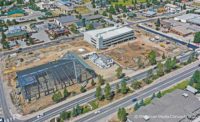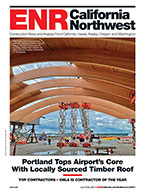Idaho Power’s new $45-million Hemingway substation near Melba, Idaho, will be the terminus of two transmission lines. The lines, nearly 1,450 miles long, are components of a proposed 500-kV transmission path from a substation near Boardman, Ore., 300 miles away, and another substation near Glenrock, Wyo., 1,150 miles away.


Transmission lines move electricity from its generation point to power-company customers. Hemingway is a combination of switching, controlling and voltage step-down equipment that reduces the transmission voltage electricity and then distributes it to customers in Idaho’s Treasure Valley.
Lynette Berriochoa, project information specialist for Idaho Power, says Hemingway is the company’s largest substation to date, and it has the largest voltage-carrying capacity.
“This location is the terminus of two large transmission projects,” Berriochoa says. “The footprint is about the size of 60 football fields.”
The Gateway West transmission line, jointly proposed by Idaho Power and Rocky Mountain Power, will connect new high-voltage transmission lines between the Windstar substation near Glenrock, Wyo., and Hemingway substation. The other line to Hemingway, from Boardman, called the B2H, will deliver power from the west.
Segments of the Gateway West project will be built during the next several years with the first component set for completion in 2014. “We are in the process of getting the route permitted, and it will take years because they are huge projects,” Berriochoa says.
Idaho Power and Rocky Mountain Power are working with the Bureau of Land Management as it conducts the environmental review and analysis for Gateway West.
Idaho Power has selected a proposed route for B2H and submitted it for the federal and state permitting processes with completion slated for 2015.
Desert Site
Dale Osterman, project engineer geologist for Terracon Consultants of Boise, says that before Hemingway, the area was nothing more than a sagebrush-covered, high-plains desert. Environmental impacts were minimized with significant planning to protect both equipment and the environment.
When Idaho Power officials looked at possible sites for Hemingway, sensitive plant and wildlife habitat and adjacent land-use compatibility was taken into account. They took advantage of the hilly terrain to make the substation less visible by placing it near or below eye level.
Mike Bracke, construction manager for Idaho Power, says environmental protection was of great concern because there are 60,000 gal. of oil used to cool the transformers and reactors onsite.
Mick Cole, construction manager for Power Engineers of Boise, says great care has been taken to protect the environment of the station and surrounding area. “Everyone of the reactor pads and transformer pads has an oil containment wall built around it with more than enough capacity to retain any oil.”
Osterman says that it was a straightforward project other than its size. “The biggest thing was that there was a large amount of site grading needed to get an area big enough to build a substation of that size,” he says.


